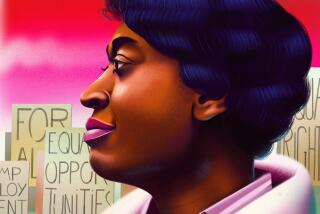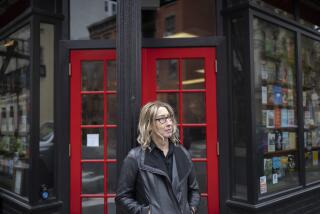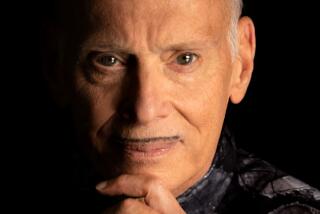On film and in exhibits, a full picture of Milk
SAN FRANCISCO â The sight may be a little shocking, Paul Boneberg warned a visitor. And it was.
There, removed from tissue-paper wrappings in a storage box, were the wingtip shoes, striped suit and white shirt that gay activist and San Francisco Supervisor Harvey Milk wore Nov. 27, 1978, the day he was assassinated. Dark bloodstains remained visible around the shirt collar, and small holes -- from bullets -- could be seen in the suitâs blue and gray material.
The suit has been preserved 30 years for a purpose, explained Boneberg, executive director of the Gay, Lesbian, Bisexual, Transgender Historical Society in San Francisco, which owns it. âItâs an iconic reference to what occurred, that this was a real man who bled real blood,â he said.
Now the clothing and many other Milk-related items in scholarly and library archives in San Francisco are about to get more attention -- as are re-creations of them in the new film biography âMilk,â which stars Sean Penn as the nationâs first openly gay man elected to a major political office.
The movieâs director, Gus Van Sant, and his team did extensive research at the historical society to accurately portray Milkâs life, his possessions, his political career and his slaying at age 48. In addition to the evocative suit, they studied Milkâs campaign posters, his round dining room table -- a replica of which is featured in the film -- and photos of the early days of gay liberation in the cityâs Castro district.
The filmmakers also dug into a large trove of Milkâs papers, love letters and photos at the San Francisco Public Library. In addition, screenwriter Dustin Lance Black interviewed surviving friends and examined their memorabilia.
âWe made a conscious effort to keep it real,â said Bill Groom, the filmâs production designer. With authenticity so important in filmmaking, âall that stuff was really helpful. We discovered a lot that enriched the movie.â
The research for âMilkâ was an unusually productive example of how archives and scholarship can influence Hollywood and popular culture, participants said.
At the same time, the low-profile library and history collection are hoping to bask a little in the filmâs afterglow. Both the GLBT Historical Society and the San Francisco Public Library are holding public exhibits timed to coincide with the movieâs opening last week and the 30th anniversary of Milkâs murder.
âThere is a symbiotic relationshipâ between the movie and the exhibits, said San Francisco city archivist and library official Susan Goldstein. But she added that the Milk archive has long been one of the libraryâs most frequently visited collections by historians and writers and âwill be used beyond the life of this movie.â
Milkâs life was the subject of Randy Shiltsâ 1982 biography, âThe Mayor of Castro Street,â and the 1984 documentary âThe Times of Harvey Milk,â which won an Academy Award. Still, the new film, which was shot in San Francisco, will help place gay history into mainstream culture, Boneberg said. âTo what degree it brings attention to [the historical society], I donât know. But I think a lot of people who come to San Francisco come to look for a deeper understanding of that history, and weâre the ones who can help.â
Many of the Milk items were donated to the historical society and city library by Elva Smith after the 1995 death of her son Scott Smith, Milkâs lover and heir, portrayed in the movie by James Franco.
The library exhibit, âHarvey Milk: Private Life/Public Life,â includes family photos, love letters, political documents and a transcribed confession of Dan White, the former San Francisco supervisor who fatally shot both Milk and San Francisco Mayor George Moscone in City Hall. (White had resigned his position and wanted Moscone to reappoint him, a request Milk opposed and the mayor refused.) The show runs through Jan. 10 at the cityâs main library at 100 Larkin St.
The GLBT societyâs âPassionate Struggle: Dynamics of San Franciscoâs GLBT Historyâ places Milk in the context of other events and artifacts, including souvenirs from early gay bars, the sewing machine that made the first rainbow flag and pioneering posters about AIDS. The show, which is to run through mid-October at a storefront at 499 Castro St. in the heavily gay neighborhood, increases visibility for the society; the organization usually holds exhibits at its loft-like headquarters in a downtown office building.
One of the most powerful displays consists of Milkâs suit and shoes, placed in a transparent case in a way that reveals but does not flaunt the bloodstains. In another exhibit five years ago, the suit was shown on a mannequin, prompting complaints of ghoulishness, which Boneberg said he tried not to repeat.
The suit is accompanied by a line from Milkâs taped premonition, partly quoted in the film, that he might be assassinated and his exhortation that gays come out of the closet. âIf a bullet should enter my brain, let that bullet destroy every closet door,â he said.
At the societyâs headquarters on Mission Street, a barber-like chair from Milkâs onetime camera shop in the Castro district is kept in storage, as are many smaller Milk items. Archivist Rebekah Kim donned gloves to unwrap some that will not be publicly displayed: an Ernie doll from âSesame Street,â a figurine of Popeyeâs rival Bluto, rolling papers for marijuana cigarettes, belt buckles with campaign slogans, and Zippo lighters. âIt does speak to Harveyâs personality, some of the quirkiness to him,â she said
Rather than constructing a set, the filmmakers took the unusual step of re-creating Milkâs political headquarters at its actual location, even though it has been a gift shop for years. Archival photos were crucial in that effort, Groom said. âItâs funny how things work back and forth. Life imitates art and art imitates life and back and forth,â he said.
Sometimes, such faithfulness can be complicated. Before it was donated to the GLBT archive, Milkâs dining room table had suffered many scrapes. So for the scenes in which Penn sits at the table and tape-records Milkâs instructions in case of his death, set decorators made a table that included similar scars.
Groom then had the replica repainted for a newer look, closer to how it probably appeared in 1978 âwhen Harvey used it,â the designer said.
(For more information about the exhibits, visit glbthistory.org and sfpl.org/news/exhibitions.htm.)
--
More to Read
Only good movies
Get the Indie Focus newsletter, Mark Olsen's weekly guide to the world of cinema.
You may occasionally receive promotional content from the Los Angeles Times.











